Concepts like “place” and “presence” can get really mushed up when you’re working in the metaverse. I’ve been puzzling about these concepts so intently over the last couple of weeks that I was actually motivated to do some (*gasp*) scripting to see if I could mediate that “sense of presence” in Second Life. Let me explain.
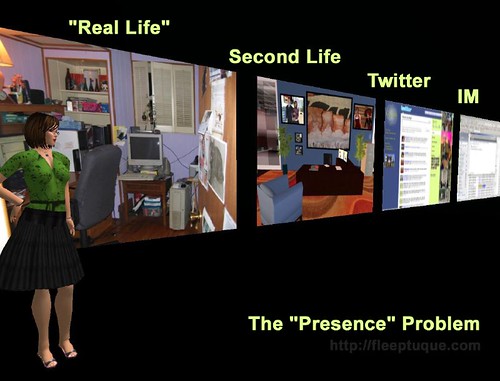
Right now I am sitting at my desk in my office at home physically, and at least nominally I’m also sitting at my desk in the Chilbo Town Hall virtually (which is where I park my avatar to let people know I’m probably off in another window instead of paying attention at that moment), AND I’m also “on” Twitter and IM. So, if you wanted to get in touch with me for a synchronous conversation or “visit” with me, you could come to my house in Cincinnati and ring the doorbell, but a) that would probably freak me out unless you’re a really good friend and b) being an internet peep, you’re more likely to send me an @fleep or DM on Twitter, or if we’re good friends you’ll poke me on Gtalk or AIM or send me an SMS on my cell, or if you’re a Second Life resident, you’ll log in and look for me in the Town Hall.
So many places I’m in at once, and that’s just trying to keep things simple – we’re not even including all the asynchronous options. But if you asked me “Where are you right now?” the answer I’m likely to give depends on context – if you called me on the telephone or sent me an SMS I’d say I was at home, but if you IMd me the same question in Second Life, I’d say I was in Chilbo, and if you asked me on Gtalk or AIM or Twitter, I don’t even know which way I’d answer. BUT, the truth is, I’m am in all those places and locations and “mental spaces” simultaneously – and yet it’s not REALLY simultaneous because my attention can only be focused on one “space” at a time.. Or is that really true?
And forget about me for a moment, “where” are all my friends right now? What are they up to and if I have a question or want to visit with them, “where” do I go to find them? With so many options and each relationship/friend connected to me in different ways through different media (some are on Twitter, some aren’t; some are in Second Life, some aren’t, etc.) it gets to be quite complicated not only figuring out where _I_ “am” but also where my friends “are” too.
This is probably a round-about way of approaching this issue, but that’s how the question/problem presented itself to me a few weeks ago when I was crunching numbers from the Chilbo Community census data and saw many comments that Chilbo often felt “empty” and that the residents of Chilbo didn’t know as many other residents as they’d like. I was a bit surprised by that finding, since the traffic reports show Chilbo gets pretty steady traffic, between 700-900 visitors per week, and because I am connected to so many Chilbo folks on so many different platforms, Chilbo rarely feels “empty” to me because even if a Chilbo resident’s avatar isn’t in the sim at that particular moment – I still “hear” what they are up to on Twitter and can still contact them any time through Second Life IM or Gtalk or wherever. I have a sense of where people are from all these other tools and that tenuous connection is enough to convey their “presence” to me that it doesn’t matter that they are not physically in the room with me or virtually in the sim with me. But are others having that experience?
If you’re not on Twitter or other web places, does Chilbo seem even more “empty” or disconnected than if you are? And could that be mediated with some way to “blend” these spaces?
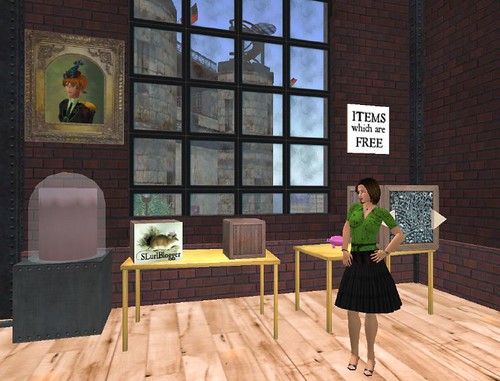
That was my question. And so I embarked on trying to modify Ordinal Malaprop‘s fantastic TwitterBox script to see if I could attempt to blend two different “spaces” together – the virtual location of the Chilbo sim and the .. “mental space” of Twitter (and if you use Twitter and SMS on cell phones, you know Twitter can be used on the go just about anywhere you are physically).
Now I should note, despite taking a programming class (I got a B+ and was thrilled), I remain stubbornly obtuse when it comes to understanding all of the logic involved in scripting. The lines of code, the variables, the repetition, the test-fail-test-fail all to no avail.. I find it incredibly frustrating. And, it turns out that in my ignorance, I attempted to modify the wrong script – instead of working on the basic one Ordinal gave me, I began with the more complicated one, so this probably took me many many many hours longer than it should have, and I was determined to try to figure it out myself and not bug one of my coder friends to help me, so it was an even longer time before I realized I’d taken the hard path. Doh. However, I am very pleased to report that THIS “Fleep Tries to Program” story has a happy ending! I eventually had to ask for help, but I learned much more about the Linden Scripting Language than I probably have in ages, and I have a working prototype going in-world, so I think all the torture and 3AM nights was worth it.
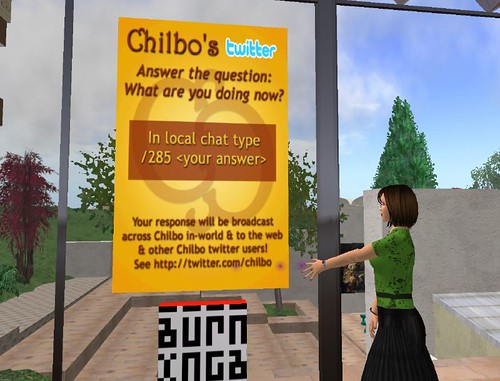
So what does this thing do? Considering all the effort it took, it sadly does not do your dishes or laundry. What it does do is a) imports tweets from the Chilbo Twitter account and all the people that account “follows” and reports them back out into the Chilbo sim in Second Life by printing the line in local chat and b) allows anyone in the Chilbo sim and within local chat range to send a tweet OUT of Second Life to the web world (through the Chilbo account).
So, if you’re walking down the street in Chilbo and happen to be near a Twitter station, you might hear a little birdie tweeting sound and see text appear on your screen that says “fleep: I’m waiting in line at the grocery store” and a few steps further down the road one that says “malburns: I’m visiting this cool sim in Second Life” or whatever our tweets might say. If you know Fleep and you know Malburns, even if they are not there in Chilbo with you, might you feel that Chilbo is less empty if you have some sense of what Chilbo people are up to at any given moment? Does it change your sense of presence if in some ways Second Life and Twitter are blended together so that your attention does not have to be focused on one OR the other, but can engage with people in both spaces at the same time?
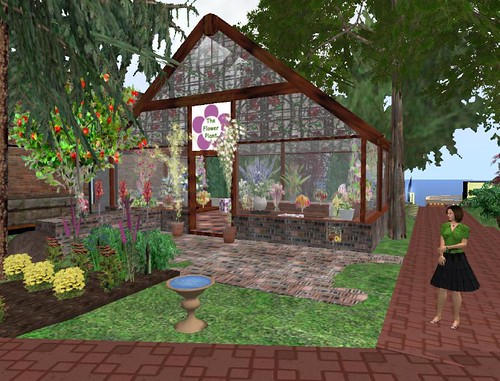
Will it change the sense of “community” and “connectedness” the residents of Chilbo feel with each other if they can send and see communications to and from Second Life even without being logged into Second Life, or for that matter, even if they don’t have personal Twitter accounts?
I don’t know, but that’s what I’ve been working on lately. I guess we’ll see how it works out. I’m still tinkering with the script, but if you’d like a copy in progress just let me know..

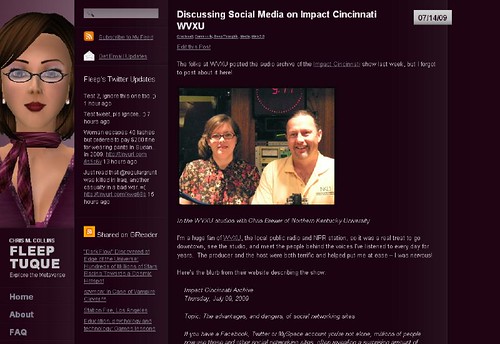




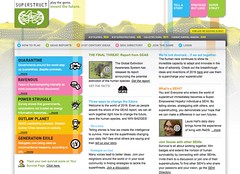


![Reblog this post [with Zemanta]](http://img.zemanta.com/reblog_c.png?x-id=f831edc0-881a-44cb-b491-b43107ea47bf)
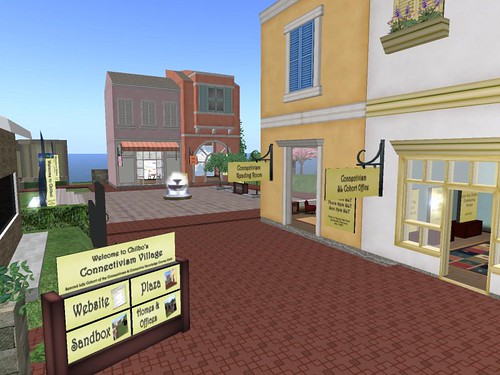
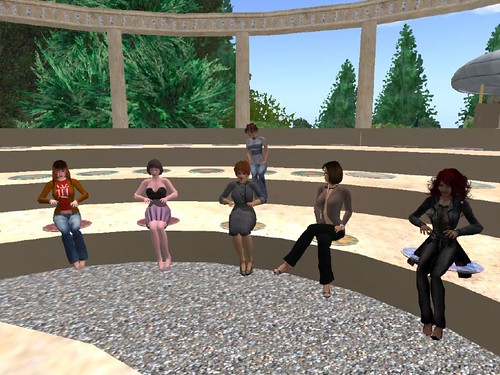
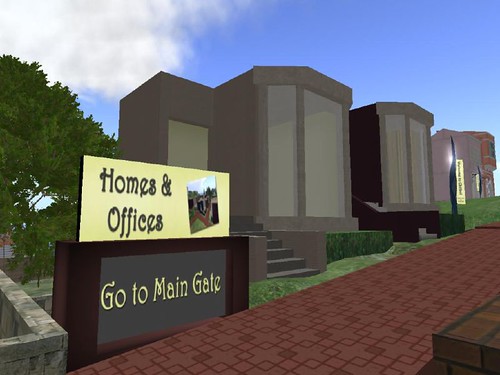
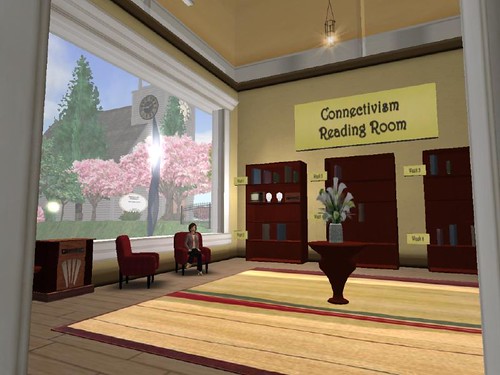

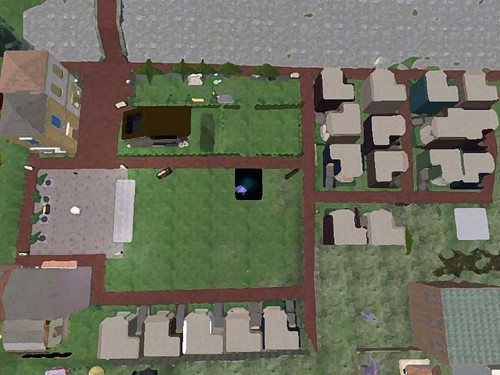
![Reblog this post [with Zemanta]](http://img.zemanta.com/reblog_c.png?x-id=03eb08ee-fe1b-46f0-ad4c-1de4fb485cf9)

![Reblog this post [with Zemanta]](http://img.zemanta.com/reblog_c.png?x-id=95bddbe6-dd0d-43fa-8a64-c14576474127)